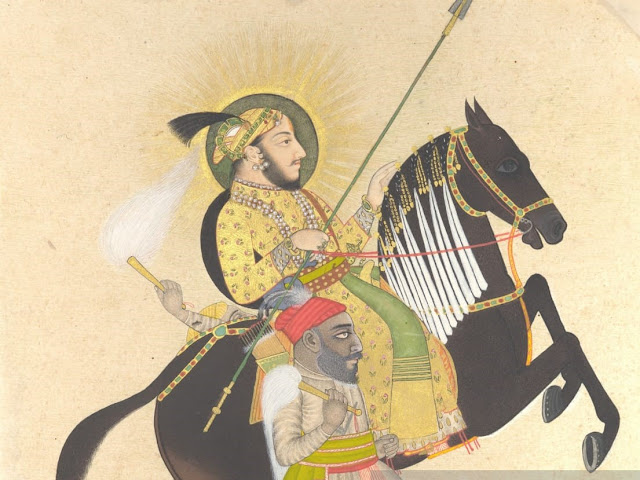• Introduction:
Mewar is a land of warriors, many warriors
were born here and fought for their land with valor. Rana Sanga was one of
those outstanding figures. His full name was Maharana Sangram Singh.
Despite being completely damaged by one arm,
one eye, and one leg, he did not give up on life and fought many wars.
No warrior, no enemy could kill them, but what
can anyone do when some betray their own. Let's know about such an invincible
Mewari warrior, about the war of Khanwa and the facts behind his death.
• Life:
Maharana Sangram Singh Sisodiya was an Indian
ruler of Mewar during the 16th century. Sanga became the ruler of Mewar after a
battle for succession with his brothers uniting the Rajputs after 300 years.
He was the son of Rana Raimal and was given
the throne in 1509 after he fought against the Afghan of the Lodhi dynasty of
Delhi sultanate and later against Turkic Mughal emperors of Ferghana.
He was the grandson of Rana Kumbha.
His ruling period was 1509-1527, Rana Sanga
married to Rani Karnavati. Sanga was born on 12 April 1472 in Chittor Mewar and
died on 30 January 1528 in Kalpi.
He bravely defended his kingdom from the
invasions of the Mughal emperors of Delhi, Gujarat, and Malwa. After defeating
Sultan Mohammad ruler Mandu in the war and imprisoning him, he handed over
Mandu's kingdom again with a generosity which showed his bravery. From
childhood to his death, his life was spent in wars. It is described in history
that the weight of the sword of Maharana Sangram Singh was 20 kg.
• Interesting History of Sanga's War:
The kingdom of Maharana Sanga surrounded the
states of the Mughal Sultans of Delhi, Gujarat, and Malwa. Delhi was occupied
by Sikandar Lodi, Mahmud Shah Begada in Gujarat and Naseeruddin Khilji Sultan
in Malwa. Maharana fought in one place with the combined power of the three
sultans, yet Maharana won. From Sultan Ibrahim Lodi in the Khatoli plain on the
border of Bundi the war took place in 1574 (AD 1517). Ibrahim Lodi was defeated
in this battle and fled.
Maharana lost his eye into a mutual fight
between the brothers in his youth and in this war his left hand was cut with a
sword and had become lame for always with an arrow in the knee of one leg.
The Maharana avenged his humiliation by
defeating the Sultan Muzaffar of Gujarat at Eidar, Ahmednagar and Bisalnagar in
the battle and reinstated the feudal Raimal Rathore on his side.
Nizamulmulk, the vassal of Ahmadnagar, fled
from the Eider and went to the fort of Ahmednagar and waited for the Sultan to
arrive. Maharana seated Raimal on the throne of Eider and besieged Ahmed Nagar.
The Mughals started the fight by closing the doors of the fort. In this war,
one of Maharana's famous Sardar Dungarsingh Chauhan (Vagad) was badly injured
and many of his brother's sons were killed. Dungarsingh's son Kanhasingh showed
great valor. When the elephant failed to break the door due to the sharp spears
on the iron gate of the fort, the heroic Kanhasingh stood in front of the Bhals
and told the Mahavata to throw the elephant on my body. The elephant turned on
Kanhasinh, causing his body to be snatched from the bears and he died at that
moment, but the doors also broke. This increased the enthusiasm in the Mewari
army and they entered the fort with naked soles and cut the Mughal army. The
Nizamulmulk who received the title of Mubarizulmulk was also greatly injured
and the entire Sultan's army dispersed and fled to Ahmedabad.
• Relation with Meera Bai:
The eldest son of Maharana Sanga was named
Bhojraj, who was married to Meerabai, the daughter of Ratan Singh, younger brother
of Rao Veeramdev of Merta. Meerabai was the only daughter of Ratan Singh, the
fourth son of Rao Duda of Merta.
After his mother died in childhood, Rao Duda
was called to Mirabai and she was brought up. Marriage of Meerabai and Kunwar
Yuvraj Bhojraj died a few years after Maharana Sanga was with Kunwar Bhojraj in
1573 (AD 1516).
Meerabai was interested in devotion to God
since childhood. His father Ratnasingh Rana was killed in the battle of Sanga
and Babur. After the death of Maharana Sanga, the younger son Ratansingh became
the successor and he too had a degree in V.S. After he died in 1588 (AD 1531),
Vikramaditya sat on the throne of Mewar. Meerabai's uncommon devotion and fame
of hymns had spread far and wide so that saints from far away used to visit
her.
• Khanwa war and death:
First taking the advantage of internal strife
in the Delhi Sultanate, he expanded into North East Rajasthan after defeating
Ibrahim Lodi in the Battle of Khatoli and Battle of Dholpur.
Following the victory of Babur over the Lodhi
Dynasty, Sangram Singh gathered a coalition of Rajputs from the kingdoms of
Rajasthan. They were joined by Muslim Rajputs from Mewat and Afghans under
Mahmud Lodhi, the son of Sikandar Lodhi of Delhi. This alliance fought against
Babur in the Battle of Khanwa to expel Babur from India. The Rana attacked the
Mughal advance guard on 21st February 1527 and completely decimated it.
Reinforcements sent by Babur met the same fate. The battle of Khanwa turned
into a disaster for Rana when Silhadi was Defeated; the Mughal victory was
decisive and turned out to become Rana Sanga's first and last defeat. Rana
Sanga wanted to prepare another army and fight Babur. However, on 30 January
1528, Rana Sanga died in Chittor, apparently poisoned by his chiefs who held
his plans of renewing the fight with Babur to be suicidal.
Writer-YASHI AGRAWAL


Keep it up bro
ReplyDeleteThanks ��
ReplyDeletePost a Comment
Ask your Queries here